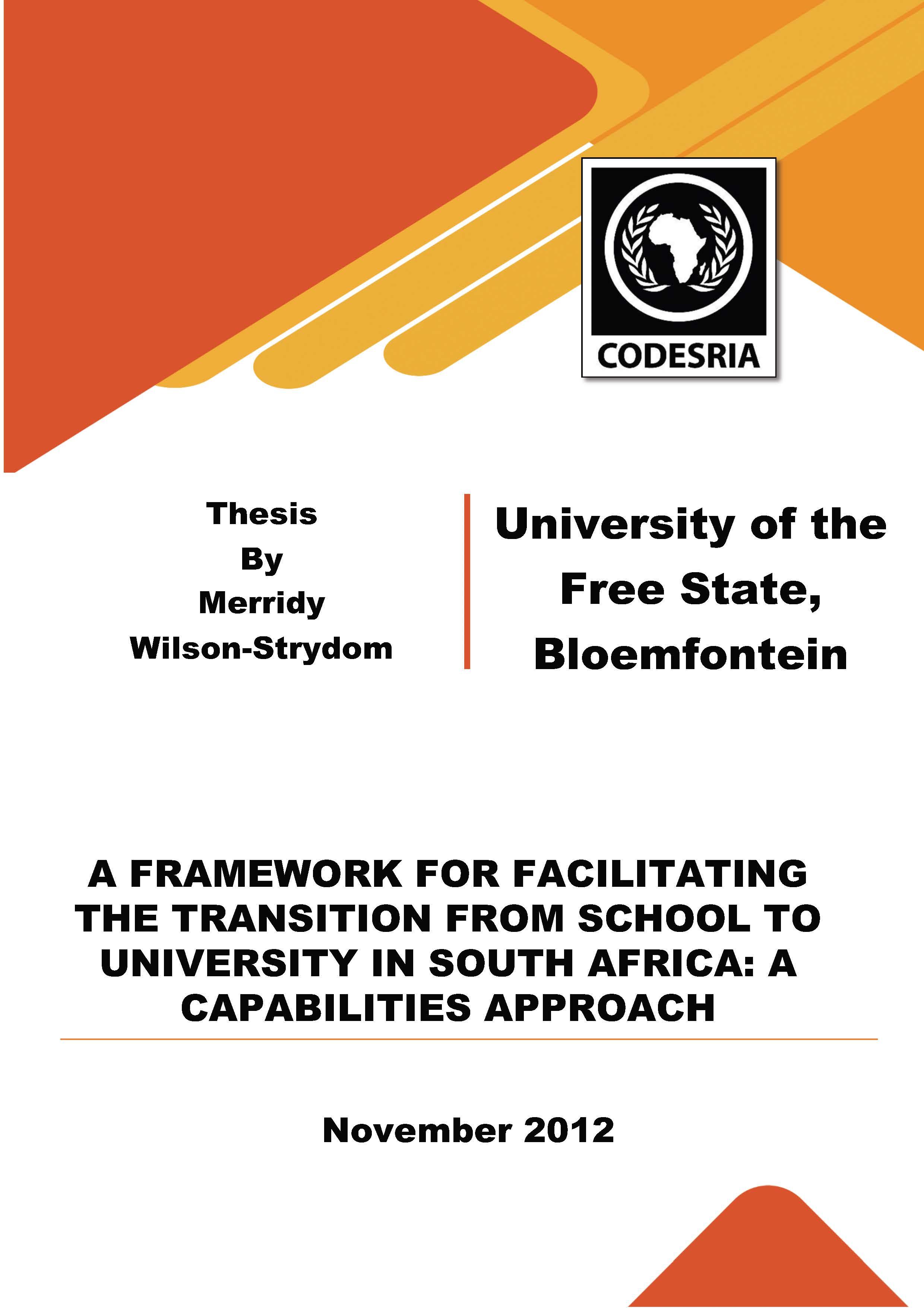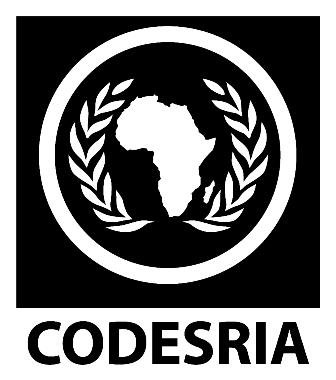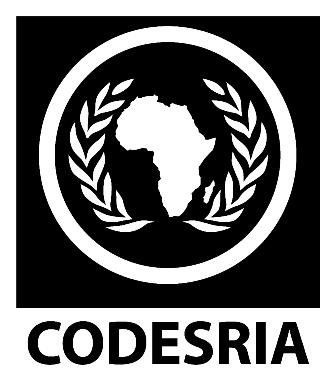A FRAMEWORK FOR FACILITATING THE TRANSITION FROM SCHOOL TO UNIVERSITY IN SOUTH AFRICA: A CAPABILITIES APPROACH
Mots-clés :
Higher education, access, readiness, transition, social justice, capabilities approach, Amartya Sen, Martha Nussbaum, pragmatism, mixed methodsSynopsis
Access to university in South Africa has been, and continues to be, a highly contested area that is plagued with many layers of complexity rooted in the social, political and educational past and present. Situated within an overarching commitment to fair and just higher education, in this thesis I have attempted to understand the complex field of access to university. I have done this by focusing on the transition from school to university, through the lens of the capabilities approach as developed by Amartya Sen and Martha Nussbaum. The capabilities approach provides a framework for seeking to understand what young people entering universities are able to be and to do and what limits their being and doing. As such, the capabilities approach requires us to move beyond measurable access statistics to a more nuanced understanding of the agency and well-being of students admitted to university.
Four research questions guided the study.
1. How do first-year students at the UFS experience the transition to university in their first year of study?
2. How do learners in Grades 10, 11 and 12 from local UFS feeder high schools experience the process of preparation for and access to university?
3. How can these experiences of the interface between school and university be theorised using a capabilities-based social justice framework?
4. Based on the evidence from the research, what interventions could support efforts towards a more socially just transition for these students?
Working within a pragmatic paradigm, the study employed a mixed methods research design. My starting assumption was that in order to thoroughly understand the transition to university, it is necessary to study both the final years of schooling and the first-year at university. As such, the study focused on the University of the Free State (UFS) and a sample of 20 feeder schools. A total of 2816 learners in Grades 10, 11 and 12 completed the quantitative South African High School Survey of Learner Engagement (SAHSSLE) (adapted from the version used in the United States) in September 2009. The SAHSSLE provides a
wealth of data regarding educational practices at school as well as learners’ experiences and attitudes towards their education. A smaller sample of 33 learners also completed qualitative reflections on their school experience, plans for universities and their ‘university knowledge’. At the university level, I collected qualitative data from 128 first-year students in 2009 using focus group methodology. In 2010 an additional sample of 142 first-year students were asked to provide a written description of their first month at university and to draw a picture of how they experienced the transition.
The thesis covers much theoretical ground related to higher education and social justice as well as in the specific study area of access. In the access domain I make use of Conley’s multidimensional model of university readiness together with research on effective educational practices that underpins the student engagement literature and instruments. Drawing on the theory and literature, I propose an ideal theoretical capabilities list for the transition to university. Following a detailed presentation of the empirical results structured in two main sections, namely: transition to university experiences and readiness for university; I then make use of the capabilities framework to theorise the transition to university.
Taking the well-being of students as the starting point, the capabilities framework for the transition to university asks what the outcome of a successful transition should be. Rather than defining success merely as measurable performance (such as changing enrolment demographics, credits passed in the first-year or progression to the second year of study for example) which does not take student well-being into account; the capabilities framework presented argues that educational resilience should be regarded as the outcome of a successful transition to university.
In this context, resilience is defined as follows:
• Being able to navigate the transition from school to university within individual life contexts;
• Being able to negotiate risk, to persevere academically and to be responsive to educational opportunities and adaptive constraints; and
• Having aspirations and hopes for a successful university career.
A pragmatic capabilities list and framework for the transition to university is proposed and defended, together with specific recommendations for how this framework could be applied to facilitate the transition to university. The seven capabilities for the transition to university are as follows:
1. Practical reason
2. Knowledge and imagination
3. Learning disposition
4. Social relations and social networks
5. Respect, dignity and recognition
6. Emotional health and reflexivity
7. Language competence and confidence.
These seven capabilities encompass the lessons learned from the literature review of university access and the first-year at university, the capabilities literature, and the empirical data within an overarching commitment to social justice and the promotion of the well-being of students. The thesis ends by considering what the UFS could do differently to facilitate the transition as well as what the UFS could do in partnership with schools.
Téléchargements
Références
Nandy, K. (2012). Understanding and Quantifying Effect Sizes. California: University of California Los Angeles (UCLA). Retrieved from http://nursing.ucla.edu/workfiles/research/Effect%20Size%204-9-2012.pdf
Nel, C., & Kistner, L. (2009). The National Senior Certificate: Implications for Access to Higher Education. South African Journal of Higher Education, 23(5), 953–973.
Nel, C., Troskie-de-Bruin, C., & Bitzer, E. (2009). Students’ Transition from School to University: Possibilities for a Pre-University Intervention. South African Journal of Higher Education, 23(5), 974–991.
Nichols, A. H., & Quaye, S. J. (2009). Beyond Accommodation: Removing Barriers to Academic and Social Engagement for Students with Disabilities. In S. R. Harper & S.
Quaye (Eds.), Student Engagement in Higher Education. Theoretical and Practical Approaches for Diverse Populations (pp. 39–60). New York: Routledge.
NSSE. (2009). Contextualizing NSSE Effect Sizes: Empirical Analysis and Interpretation of Benchmark Comparisons. Indiana: University of Indiana, Bloomington. Retrieved from nsse.iub.edu/pdf/effect_size_guide.pdf
Nunez, A. (2009). Latino Students’ Transition to College: A Social and Intercultural Capital Perspective. Harvard Educational Review, 79(1), 22–48.
Nussbaum, M. (2000). Women and Human Development. The Capabilities Approach. Cambridge: Cambridge University Press.
Nussbaum, M. (2003). Capabilities as Fundamental Entitlements: Sen and Social Justice. Feminist Economics, 9(2-3), 33–59.
Nussbaum, M. (2006). Education and Democratic Citizenship: Capabilities and Quality Education. Journal of Human Development, 7(3), 385–395.
Nussbaum, M. (2010). Not for Profit. Why Democracy Needs the Humanities. Princeton, New Jersey: Princeton University Press.






